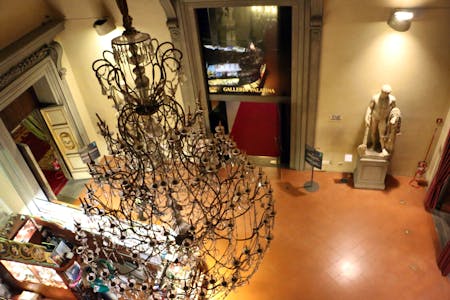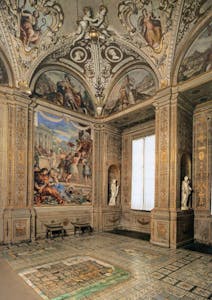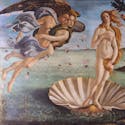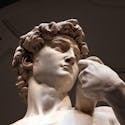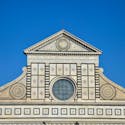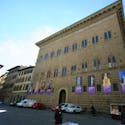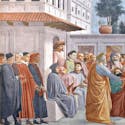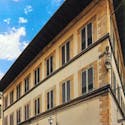Grand Ducal Lifestyle mixed with Renaissance and Baroque Collections
The Palatine Gallery twists four centuries of Grand Ducal Tuscan lifestyle with Renaissance and Baroque paintings. Lavish, sumptuous chambers of the Grand Dukes, private rooms and original public audience halls are today an exceptional setting for an outstanding collection of about 500 works (canvas and panels) formerly collected by the Medici’s. Masterpieces by Raphael, Titian, Rubens, Pietro da Cortona and other painters of the Renaissance and Baroque periods compose this priceless collection.
The paintings cover the walls of the rooms in the style of traditional 17th-century picture galleries (“quadrerie”) where the entire walls were covered with paintings. The Gallery still preserves the typical layout of a private collection, with a sumptuous combination of lavish fresco decorations and the original framed paintings. Unlike most modern museums, the layout of the museum does not follow a chronological order, nor schools of paintings. The exposition reveals instead the personal taste of the great collectors who lived in the palace. In 1828, Leopoldo I of Lorraine opened to visitors the “Gallery of the Palace”, hence the name “Palatine Gallery”.
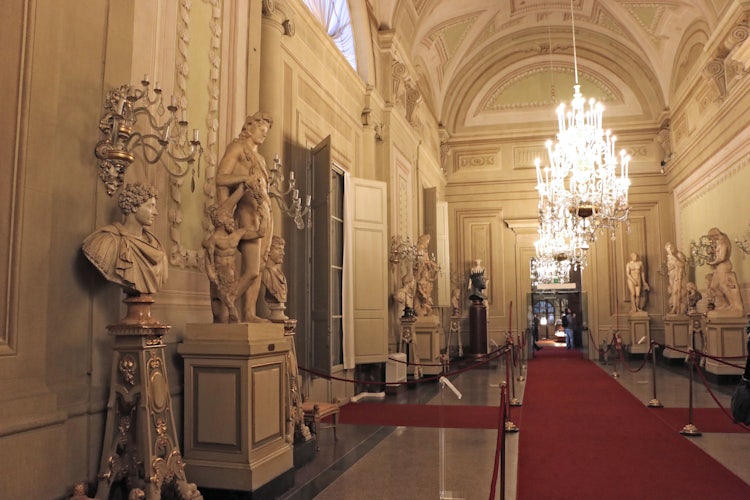
Walking through the Antechambers of the Footmen and the Gallery of Statues, formerly used as an open portico overlooking Ammannati’s courtyard, you’ll reach the Castagnoli Room. From this room, the Gallery offers two sections which correspond to the former apartments reserved to the Grand Duchess (right wing, rooms 4-11 and 16-18) and to the Grand Duke (straight through the Hall of Music).
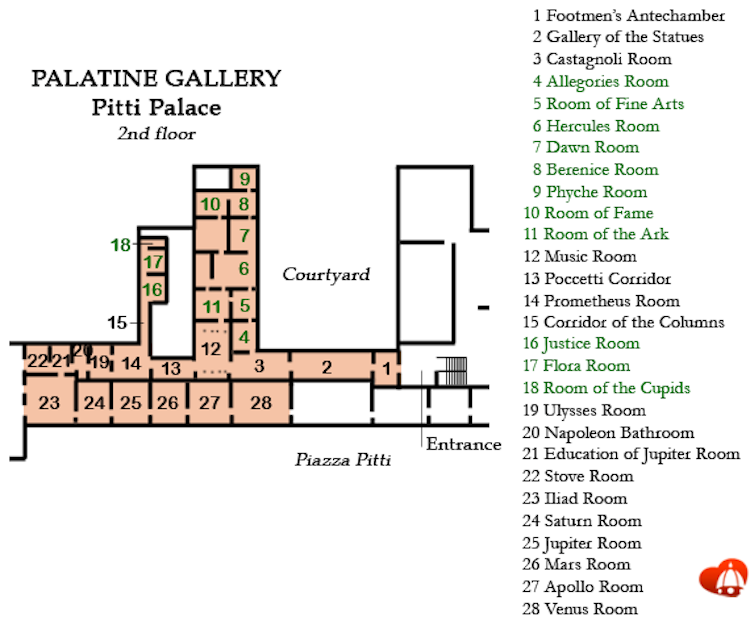
Il Quartiere del Volterrano
The right wing, known as the “Quartiere del Volterrano” is composed of the chambers used by the Grand Duchess Vittoria della Rovere, including bedroom, service rooms, private chapel and dining room (indicated in green in the map above). Note in particular the frescoed ceilings in the Allegories Room where you can still admire 5 frescoed scenes from 1658 by Baldassarre Franceschini (also known as “Volterrano”) with themes alluding to the duchess's devotion and moral virtues. Vittoria della Rovere played an important role in the cultural inheritance of Florence who, as part of the House of Urbino, brought to Tuscany an invaluable collection of paintings as part of her wedding dowry to Ferdinand II Medici, including the works by Titian and Raphael still part of the city's collections.
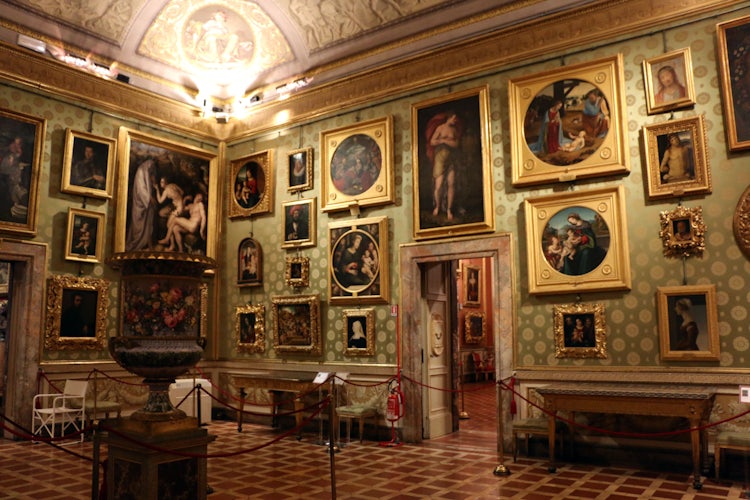
Those who requested an audience with the duchess were granted one in the Hall of the Ark, which today retains the decorations carried out during the era of Napoleon’s rule by Luigi Adamollo (1816). The room is decorated with a large frieze that illustrates the Lorraines triumphant return to governing Tuscany after the Restoration.
The last rooms of this wing – Dawn Room, Berenice Room, Psyche Room) were also used as the private residence of Cardinal Giovan Cardo dei Medici, brother-in-law to Vittoria della Rovere, who was also a patron of the art but most remembered for founding the Teather of the Pergola. The Berenice Room was, in particular, used as an “antechamber for gentlemen and bedroom for the secret butler of the cardinal”. Among the paintings in this room, there are several important works by Salvator Rosa and painters of the Venetian School from the Renaissance.
Most of the ceilings in this area were majorly transformed in the early 19th century when the Dukes of Lorraine commissioned Italian painters like Bezzuoli, Martellini and Pietro Benvenuti to modernize the rooms to follow the Florentine fashion of the time.
The Grand Duke's Apartments
This section of the Galleria showcases the most important core of works found at the Palatine Gallery. Starting after the Hall of Music and the Poccetti Gallery, about 10 rooms decorated splendidly with frescoes by Pietro da Cortona, stuccoes and reliefs of mythological characters to celebrate the House of Medici act as the impressive framework for the important works by Raphael, Botticelli, Filippo Lippi, Titian and Caravaggio on show.
Starting in the Room of Prometheus, used as the meeting hall for the Council of the Gran Duchy during Medici rule, today hosts some of the oldest paintings of the collection and in particular 12 “tondi”, round-shaped paintings loved by Florentine patrons but which were inserted into square neo-classical frames in later periods. Admire the most famous of the tondi, the Madonna with the Child by Filippino Lippi (15th century) known as the “Tondo Bartolini”, and two portraits done by Botticelli., including the “Bella Simonetta”. The room is named after the subject of the frescoes done by Giuseppe Collignon (between 1809 and1814), with a Prometheus stealing divine fire while being protected by Minerva.
The following hall, the Room of Ulysses, frescoed in 1815 by Gaspare Martellini, used to be the Grand Duke's private bedroom. It contains the large painting Madonna and Child by Raphael (“Madonna dell’Impannata”) from around 1514. where you can admire the typical Renaissance costume of covering up the window frames to keep in the warmth in the rooms.
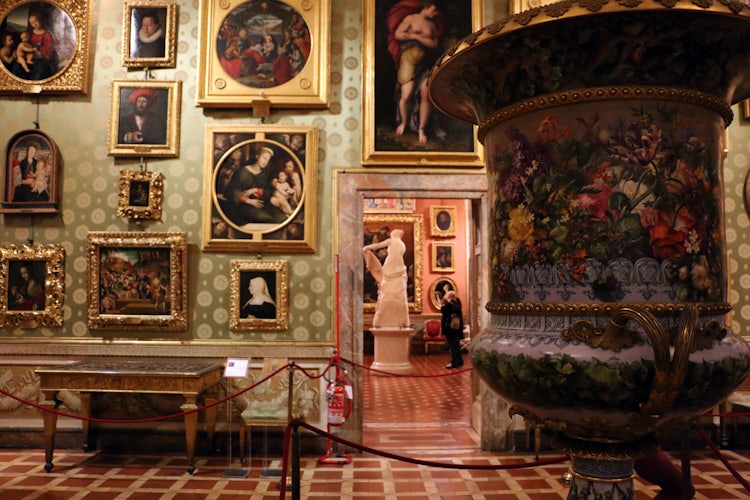
Passing by Napoleon’s bathroom, you will arrive at a small room once belonging to the Grand Duke’s clerks. The paintings on the ceiling were done in 1819 by Luigi Catani and show Jupiter as a young boy, as he's taken from his father Cronos. The room, called the Education of Jupiter, hosts a must-see, Caravaggio’s Sleeping Cupid, with bowstring broken and arrows cast aside. The work was commissioned by Francesco dell’Antella, Florentine Secretary for Italy to Alof de Wignacourt, Grand Master of the Knights of Malta. The painting is signed on the back and records that it was painted in Malta in 1608.
Continuing along, you will find yourself inside the precious and elegant Grand Ducal bathroom calledthe “Stove room” with a multicolored majolica pavement. The grandiose paintings on the walls earned Pietro da Cortona fame in the Baroque court of the Medici. The young talented artist painted it in 1637 with “The Four Ages of Man”, commissioned by the Medici, represented the “manifesto” of the Baroque period and painting school in Florence at that time. In Florence, Pietro became the court favorite with his perfect technical skills and ability to create fascinating, scenic atmospheres. Enjoy sense of marvel looking upward to the breathtaking, Baroque decorations!
The last corridor opens up upon the Room of Iliad, once used to play “Trucco”, an ancient version of billiards. The room is named after the paintings on the ceiling and in the lunettes that depict scenes from Homer's epic poen, "The Iliad". The sculpture in the center of the room is by Lorenzo Bartolini (1777-1850) and represents Charity. Among the works, the room features two paintings by Artemisia Gentileschi, an Assumption of the Virgin Mary by Andrea del Sarto and an original portrait of a lady called “la Gravida” by Raphael (1506). The subject is a pregnant woman, conscious of her approaching motherhood, who looks intensely toward the spectator, with her hand on her abdomen.
At the time of the Medici, the following five rooms formed the Grand Duke's audience rooms who received in the throne room (Jupiter room). They are partially frescoed with an imposing decorative cycle that makes use of classical myth to allude to the Life and Education of the Prince. In these Halls of the Planets (Saturn, Jupiter, Mars, Apollo, Venus), the complex of frescoes and stuccoes are one of the most important examples of the Baroque style in Florence. The sequence in Medici times was originally intended to be admired in the opposite direction, from the Room of Venus, into the Apollo Room, then Mars Room, Jupiter Room (the room of the Throne) and ending in the Saturn Room.
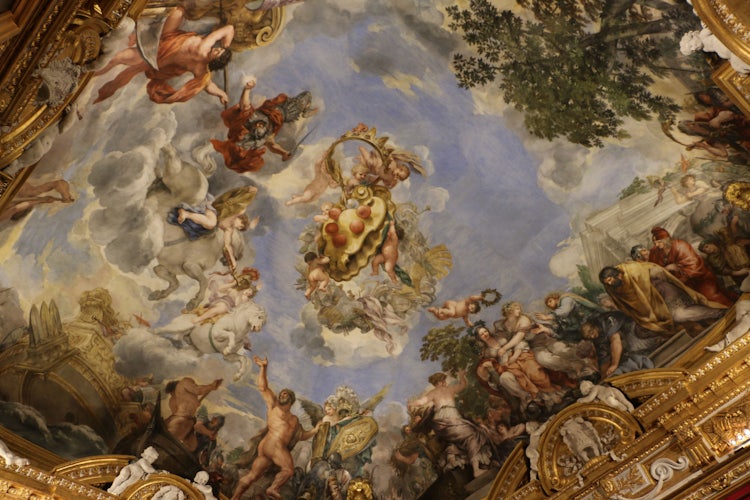
These spaces provide an exceptional frame for the displayed works displayed here from the 16th to the 17th centuries. The Room of Saturn contains the largest number of works by Raphael, among them the Portrait of Agnolo Doni (1506) and of Maddalena Strozzi, the Vision of Ezekiel, the unfinished “Madonna del Baldacchino, the Portrait of Cardinal Dovizi and of Tommaso Inghirami and, the most famous, Madonna of the Chair.The Virgin is seated on an elegant chamber chair reserved for high dignitaries of the Papal court instead of on a throne and hugs the child affectionately.
The next room, the Jupiter room, has paintings by Rubens, Andrea del Sarto, Bronzino, Perugino and the Flemish Sustermans, official painter at the Medici court. Susterman’s portrait of Galileo Galilei, the official mathematician at the Medici Grand Ducal court dedicated all of his astronomical discoveries to the Medici. In the same room is Raphael’s very elegant Veiled Lady (1515). The woman, whose head is covered by a veil, prerogative of married women with children, is shown in profile, highlighting her puffed up, silk sleeve: the light color of the silk creates deep folds and bright reflections of extraordinary quality, with precious tonal variations on white on white. The golden embroidery, the necklace with painted figures and crown with precious stones peeking out from under the veil reveal the high status of the woman, who no one has been able to identify. Many believe, including Vasari, that it could be the famous “fornarina”, the artist’s beloved muse. The work is an extraordinary demonstration of Raphael's skill in the finest details. Take time to also admire Bronzino's portrait of “Guidobaldo II della Rovere” (1531), done when he was 18 years old in splendid armor made in Lombardy.
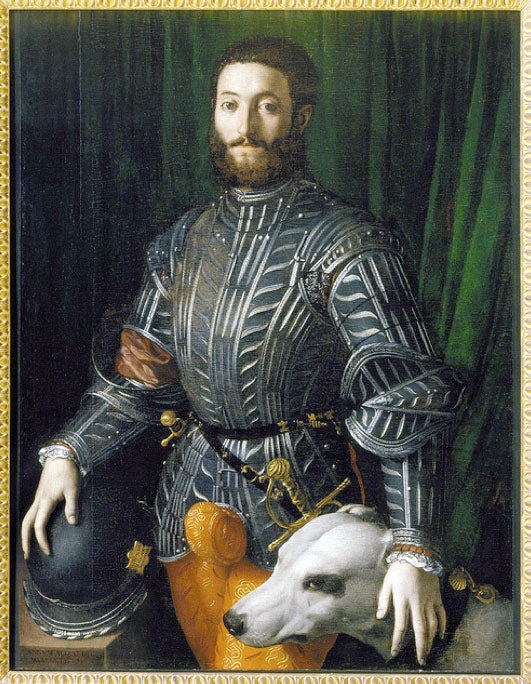
You walk under a bright sky, characterized by the central Medici coat of arms done by Pietro da Cortona in the center of the vaulted ceiling when you enter the Room of Mars. This was one of the most longed for antechambers to be in, as it was reserved for ambassadors and important persons. Take note of Rubens' Four Philosophers (Rubens portrayed himself, on the left, along with his brother Phillip, Juste Lipse and Jan Woverius).
In Medici times, the Room of Apollo was an antechamber reserved for ordinary noblemen waiting to be received by the Grand Duke. The room's frescoes were once again entrusted by Grand Duke Ferdinando II to Pietro da Cortona in 1647. In this room and in the next, the Room of Venus, you will admire several portraits by Titian, considered masterpieces for the strong personality and introspection that come out from the subjects portrayed. In particular, note Titian's “St. Mary Magdalene” and the “Portrait of Pietro Aretino”. Another work to admire is the masterpiece by Rosso Fiorentino, the Madonna with Saints (1522), from the Church of Santo Spirito.
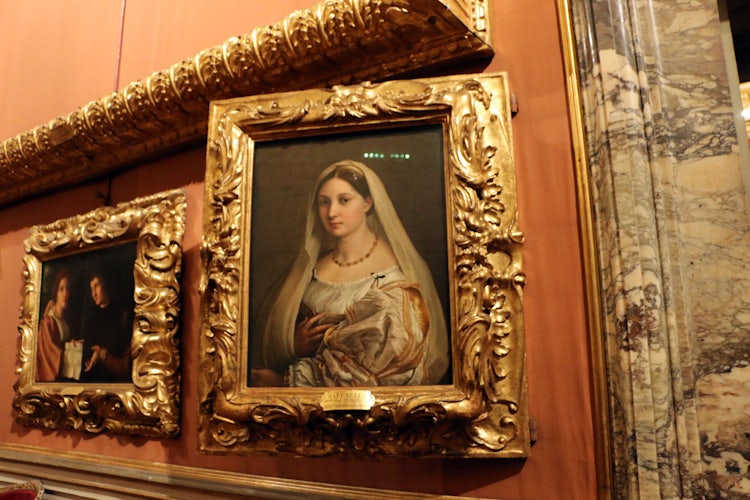
In the Room of Venus is the Venere Italica, statue by Antonio Canova commissioned by Napoleon (1810). Not to be missed on the walls, are four paintings by Titian, dating to the years 1510-1545. Among them, the Portrait of pope Julius II (1545) and La Bella (1535).
You might feel a bit dizzy at this point, after admiring so many masterpieces and interpretations of what is beautiful all around us. If you have the time, head back towards the Jupiter room, raising your eyes upward to the vaulted ceilings to take yourself back into the world of nymphs, Gods and clouds. A bit of the lightness will be the gift you can take away with you after your visit to the Palatine Gallery!
The Royal Apartments

From the Palatine Gallery, if so much beauty has not affected you with Stendhal syndrome yet, the visit continues through the Royal Apartments. The fourteen magnificent rooms which were the home of the Medici and Lorraine grand ducal families and, from 1865, of the king of Italy during the brief period that Florence was capital of Italy.
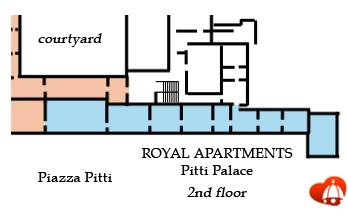
Three historical moments and styles are seen side by side in these series of rooms, giving a sense of the growth of the palace over a long period of time. Their decoration was changed to Empire style by the Savoy (king), but there are still some rooms which maintain decorations and furniture from the age of the Medici. Inthe Green Room, frescoed by Giuseppe Castagnoli in the early 19th century, you can also admire an intarsia cabinet from the 17th century and a collection of gilded bronzes. The Throne Room was decorated for King Vittorio Emanuele II of Savoy and is characterized by the red brocade on the walls and by the Japanese and Chinese Vases (17th-18th century). In the Blue Room, you can admire furniture from the 17th and 18th centuries and the portraits of members of the Medici Family painted by Justus Sustermans (1597-1681), the official Medici court painter.
We hope you've enjoyed your virtual visit to the Palatine Gallery and Royal Apartments in Florence - and hope you'll come visit them in person soon! In person, if you have energy after this visit, you can head on to the Gallery of Modern Art located on the next floor up since it is included in the same admission ticket.


